

© John Clarke 2014-
John Clarke
Historian of Brookwood Cemetery

St Edward the Martyr
Aelfthryth invited St Edward to her hunting lodge at Corfe where she arranged for her servants to welcome him, offering St Edward a cup of wine (a traditional form of greeting). As St Edward drank the wine he was stabbed in the back whilst still mounted on his horse. He fell off, but his foot caught in the stirrup and he was dragged to his death. So Aelfthryth managed to get her son on the throne. It didn’t do her much good. Ethelred didn’t particularly like his mother, and kept her in the background. She eventually came to some form of repentance, returned to her roots in the Test valley, became a nun, and helped found a convent.
The religious motive for St Edward’s murder was that Aelfthryth had support from a group of noblemen who may be referred to as “secularisers”. King Edgar had sponsored and endorsed a massive movement of reformation within the Church in England. Inspired by the Archbishop of Canterbury (St Dunstan), the Bishop of Winchester (St Ethelwold, c.908-
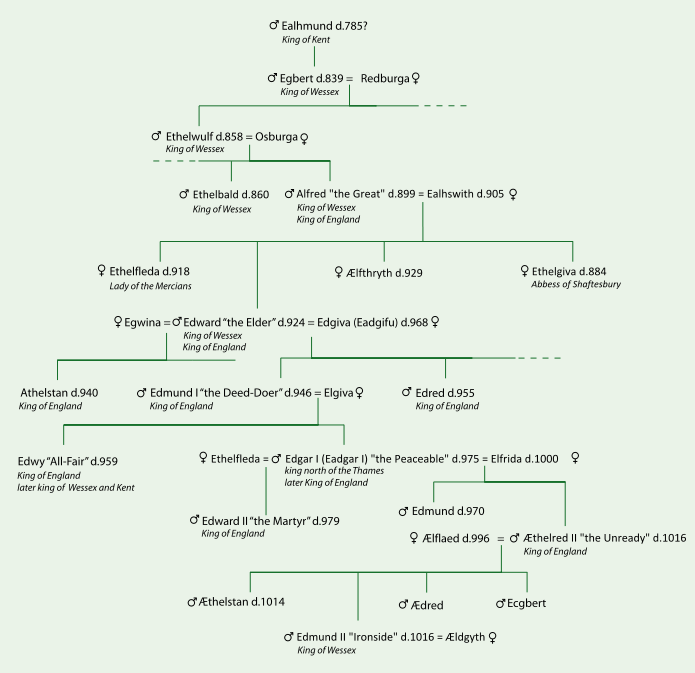
St Edward was murdered on 18 March, but the precise year is unknown. There is some controversy over the year being 978 or 979. The reason for this confusion is that the ways of calculating the church year has changed, along with variations in the secular calendar, all of which makes it uncertain precisely when St Edward was murdered. He was murdered at that time of year because he was planning to marry. Had St Edward married, he might have produced an heir and that child would have inherited the kingdom rather than Ethelred his half brother. St Edward couldn’t get married until Easter came, as you were not allowed to be married in Lent. So he was murdered in Lent.

THE DEATH OF ST EDWARD THE MARTYR
“The wicked Queen Aelfthryth” from Pictures of English History (1868). It shows the Queen offering Edward a cup of wine as conspirators gather to murder the king on 18 March 978/9.
St Edward was dragged to his death by his horse. His body was taken that evening into a cottage in the village of Corfe. This is the traditional site where the parish church now stands. It was then that the first recorded miracle took place. In the cottage lived a blind woman who touched St Edward’s body and whose sight was immediately restored. Later the body was taken away and was temporarily buried at Wareham. If you go to Wareham and visit the parish church (St Mary’s), you will find there is a side chapel which is still dedicated to St Edward. Within the chapel is one of those stone coffins which they admit is not the coffin he was buried in, but it might have been. In fact the coffin is of a different period and of a different date.
Due to the number of miracles that were worked through his prayers and intercession, in the year 1001 St Edward’s body was taken to Shaftesbury Abbey. Why it was taken there is not clear. It might have been moved because Shaftesbury had the largest monastic community in the whole area at that time, and it was very well defensible. If you visit the site today you will find it is right on top of a hill and you can actually see one way to the English Channel and in the other direction out across to the Bristol Channel. The monastic community had been established there about 100 years before by Alfred the Great, one of whose daughters became a nun there. Another person who had become a nun at Shaftesbury was St Edward’s grandmother, so it may be that there was just a strong link with the royal house of Wessex. His grandmother had already died when St Edward was murdered, so her body would have already been there. The probability is that they took St Edward’s body to Shaftesbury because of the family link along with the pre-
So St Edward was buried in Shaftesbury Abbey. Once again a whole series of miracles happened culminating in the last one where his grave started pushing up from the ground. They decided that the Saint obviously no longer wished to be buried, but that his relics should be properly enshrined. So his body was taken up from out of the ground and was placed in a casket in a shrine within the Abbey. Although this story of a body pushing up sounds rather odd to us (we’re not used to these things now), about three years ago exactly the same thing happened in Romania. We’re not quite sure who exactly “pushed up” there, but this incident happened after the fall of Ceausescu and the communists, when monasteries and other religious foundations were reopened. In one of the monasteries, alongside a pathway across a courtyard, this grave area pushed up. They flattened it out, and the same thing happened. After a while they looked underneath and, finding a casket containing the remains of an elderly monk, the relics were taken and enshrined in the church. (1)
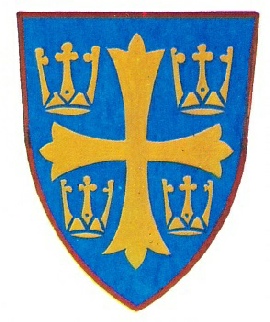
ARMS OF St. EDWARD THE MARTYR
Formal heraldry only appeared in the twelfth century, therefore this shield cannot be considered historically accurate. However later generations liked to design arms like these for the pre-
The relics of St Edward remained at Shaftesbury. At some time they did not remain whole and incorrupt. In the Abbey’s latter period it is recorded that they had his bones and his heart. They also had another curious relic -
The relics of St Edward were venerated in the monastery’s shrine until the period of the dissolution under Henry VIII in the mid-
The St Edward Brotherhood
How our community came to be custodians of St Edward’s relics is a long and complicated story. The relics were not seen again until 1931 when they were found in the grounds covering the ruins of the Abbey Church. The grounds were then in private hands (they are now owned by a Trust called “The Friends of Shaftesbury Abbey”). The site is divided since a massive late Victorian house was built over the old west end of the Abbey Church, and about three quarters of the site is “next door”. The Claridge family then owned this site, and there were two sons. One was John Edward Wilson (1905-
 In 1931 he was a young man, interested in the history of Shaftesbury and a keen amateur archaeologist. At the end of the nineteenth century there was a dig over the site, and John Wilson-
In 1931 he was a young man, interested in the history of Shaftesbury and a keen amateur archaeologist. At the end of the nineteenth century there was a dig over the site, and John Wilson-
THE RELICS OF St. EDWARD THE MARTYR
The casket containing what are thought to be the remains of St Edward the Martyr following their discovery on the site of Shaftesbury Abbey in 1931. The remains were found 2 ft. Below ground, close to the top of a set of steps during the uncovering of part of the walls of the abbey.
John Wilson-
Having found the bones he kept them. Dr. T.E.A. Stowell (1890-
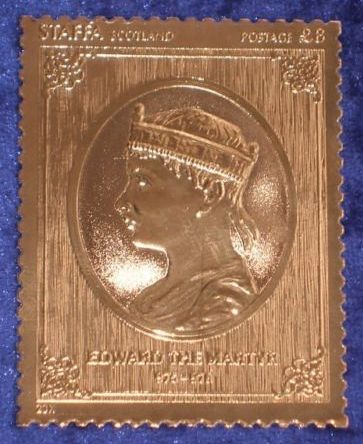 Mr. Wilson-
Mr. Wilson-
ST EDWARD THE MARTYR
As depicted on a stamp issued in 1977 by the island of Staffa to commemorate the Queen’s Silver Jubilee.
Eventually the two ladies died and the property was sold on again, and Mr. Wilson-
In the late 1970s there was on Orthodox Church based in Guildford. For a period I was detailed to go there and serve. The Guildford group heard about the relics of St Edward and in the 3 months when I served there, they asked me to follow this up. So I contacted Mr. Wilson-
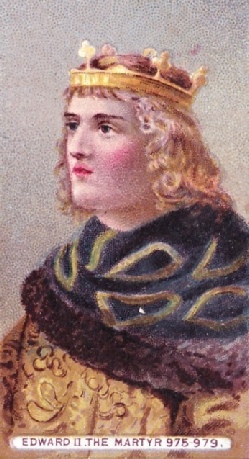 Why Brookwood? It’s at the depressing end of suburbia: wet, boggy, miserable and in the middle of a huge cemetery! But it happened that in the Guildford group there were a few members who lived nearby and who were without a church. They used to go up to London for services. One lady in this group pointed out to me that there was a church available in the cemetery, and she suggested it might be suitable for their services. One of the old Anglican chapels was up for sale at the time so we went and had a look. Quite frankly it utterly depressed me: it was half derelict, and I managed to dampen her enthusiasm. About 2 years later, the question of the relics surfaced and she came back to me, again suggesting the church in the cemetery. Frankly it was the only thing we could have afforded, and so we came to suburbia and commuter-
Why Brookwood? It’s at the depressing end of suburbia: wet, boggy, miserable and in the middle of a huge cemetery! But it happened that in the Guildford group there were a few members who lived nearby and who were without a church. They used to go up to London for services. One lady in this group pointed out to me that there was a church available in the cemetery, and she suggested it might be suitable for their services. One of the old Anglican chapels was up for sale at the time so we went and had a look. Quite frankly it utterly depressed me: it was half derelict, and I managed to dampen her enthusiasm. About 2 years later, the question of the relics surfaced and she came back to me, again suggesting the church in the cemetery. Frankly it was the only thing we could have afforded, and so we came to suburbia and commuter-
We managed to buy not only the chapel which was very derelict (this is the smaller one where we now live) but also the larger church. I felt that if we were going to enshrine the relics of St Edward, then it should be done properly. The church originally offered for sale was the older of the two and was very obviously secondary to the main one. It wouldn’t seem right to place the relics of a Saint and King in a secondary building. So I thought we ought to acquire both and put St Edward in the larger church. We managed to negotiate that. At the time the asking price was £33,000 for 5 acres of land and the two buildings. We suggested to our solicitors that we should get it valued, but he said it had no value as such because it wasn’t a marketable property. He suggested we make an offer £5,000 less, which was accepted. So we managed to buy the buildings and land for £28,000 and then set about restoring it all.
Meanwhile we moved in on site in our caravan. Here we made a series of mistakes. We estimated that we’d be in the caravan for 6 months to a year at most. Everyone we asked said the climate was mild and pleasant, so when we purchased our mobile home we didn’t bother to get a properly insulated one. We were in it for 3 years! There was no water supply, so we had to bring water from half a mile down Heath House Road then across half a mile of cemetery land. The water board wouldn’t allow us to pay for a proper supply in instalments, so we had to save up for the whole amount before it could be installed. So for about 2 of those 3 years we had no water.
We eventually moved into our new home in March 1982. On 15/16 September 1984 we actually received the relics of St Edward and had the church blessed. I personally would have preferred to wait a bit longer before the relics were received, but Mr. Wilson-
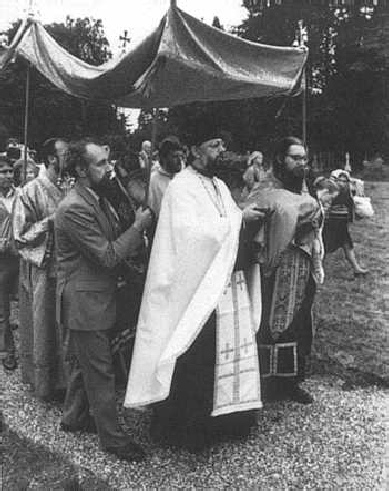
THE ENSHRINEMENT OF THE RELICS OF St EDWARD THE MARTYR
15/16 September 1984.
The High Court hearing was set for the Thursday, but it was not until Friday that a special hearing took place. The judge decided that the principal question could not be decided by that court as firstly, it would have to look into the whole documentation of the history of the relics going back over 50 years and secondly, that it would have to find out what the legal position in England was regarding the ownership of human remains. (In fact it seems that there is no legal position on this.) The judge came very close to advising the other side to drop their action, but he ruled that we should be allowed to receive the relics and to enshrine them, but that we should then deposit them back in the bank until we had security measures in our church. This was a consequence of the ownership of the relics being in dispute. When the final court case was heard, either they would win or we would win and the dispute would be ended. So we went ahead: we received the relics, the church was blessed, and the relics returned to the bank vault (now in Woking, so they were placed in our account!).
We then had a whole series of incredible happenings. We had a chap come round during our Holy Week. He told us he was a security expert, although he proved to be a private detective hired by the other side. He didn’t tell us he was coming. He happened to turn up at the beginning of our main service and had to wait seven hours until we were available! During this time he experimented with sprinting to the cemetery walls from our church to see how long it might take someone who’d stolen a relic, he stole some of our correspondence, and he took photographs of our dog Kate (for some obscure reason copies of these were sent to the Attorney General!). On another occasion a reporter from the Sunday Express came along and said he wanted to do an article on us for their colour supplement, which he did. The finished article largely comprised a series of pictures, but what he wrote contained twenty errors of actual fact. We chased them through the Press Council, which I knew probably wouldn’t do much good but would at least ensure that everything went on record. In the end the Press Council decided that twenty errors in a newspaper article was fair game and nothing to complain about.
Then another journalist rang me asking what did I think of the letter the Attorney General had sent me? I remember the date specifically because it was our Good Friday when he phoned. I said I hadn’t received a letter, and so he proceeded to read it to me. Twelve weeks later we did receive a letter from the Attorney General and substantially -
Then they responded by deciding that the relics didn’t belong to the Queen, but that they were very worried that the relics should be secure. They’ve kept to this line ever since. Eventually, as no-
The latest in this still-
Notes
(1) The coat of arms illustrated should have martlets, not crowns, in each quarter.
(2) Father Alexis has since seen this grave in Romania. It was opened and the relics removed into the church where they were laid to rest next to St Paisius Velichkovsky. The grave has been left slightly raised in order to show what happened. The authorities still don’t know whose grave it was.
Postscript
Since this talk was delivered, the court case has at last been closed. By an Order dated 31 March 1995, the Chancery Division of the High Court of Justice entirely dismissed the case. There is a remarkable significance in the date of the Order, for 31 March corresponds with 18 March in the Church calendar, the feast of the martyrdom of St Edward which is celebrated every year in the church. And so the relics of St Edward will rest in peace within the St Edward Church in the cemetery for ever.
[From Necropolis News, April 1996]
Further Reading
Hunt, William. Edward the Martyr. in Lee S (Ed.) Dictionary of National Biography. Vol. 17. London: Smith, Elder & Co, 1885. pp. 5-
Lloyd, Rachel. Murder or Sacrifice? Saint Edward, King and Martyr 973-
A booklet celebrating the millennium of St Edward’s murder. Includes a brief history and two short plays based on the stories surrounding his death. The historical notes are well presented and include references for further reading.
Stowell, Thomas E. ‘Report on the Relics of St Edward’ in The Criminologist, vol. V (1970), pp. 97-
Wilson-
Originally published in 1984 for the enshrinement of the relics of St Edward, this booklet contains notes on the life of St Edward and the recorded miracles attributed to him. It contains a very useful list of further reading inside the back cover.
The Saint Edward Brotherhood has recently published a new book on Saint Edward the Martyr. This incorporates the text of John Wilson-
Copies may be ordered direct from the Saint Edward Brotherhood using this link.
St Edward the Martyr & the St Edward Brotherhood
In November 1994 the Brookwood Cemetery Society invited Father Alexis to give a talk about St Edward and the Brotherhood. Most of the evening was devoted to the fascinating story of St Edward -

ST. EDWARD was a Saxon king. He was born c.959, and reigned from 975 to c.978/9. St Edward has no number: that is, he is not any of the I -
Edgar was a man of exquisite taste and understanding, and chose to be crowned in Bath. The main reason for this was that Bath was on the borders of Mercia and Wessex, the two most important kingdoms in England; therefore Edgar was crowned in a city allied to both. Edgar had two sons that survived him: St Edward, and the man later known to history as Ethelred “the Unready” (or Ethelred II “the Redeless”). Ethelred was bom c.968, and reigned from St Edward’s death in 978/9 until 1016. Ethelred was remarkable in two ways: first, because he reigned for a very long time (unlike most Saxon kings); and second, because his reign proved to be an absolute disaster. Ethelred was the youngest son and therefore did not succeed when King Edgar died in 975.
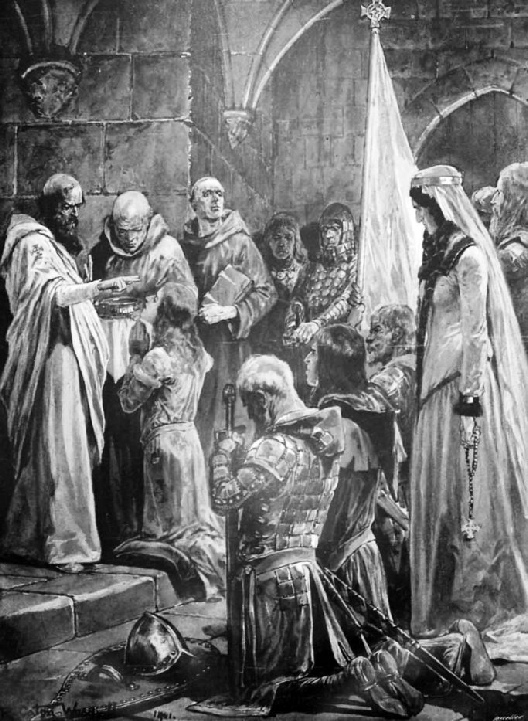
THE CORONATION OF ST EDWARD THE MARTYR
St Dunstan anointing Edward the Martyr at Kingston, AD 975.
St Edward succeeded when he was in his mid-
The dynastic reason stemmed from St Edward and Ethelred being half brothers. We know very little about St Edward’s mother and when she died. History suggests that she may have been called Ethelfleda, and that she probably died c.963/4. St Edward was very young when she died, or she may have died in childbirth. His father remarried a very beautiful lady -